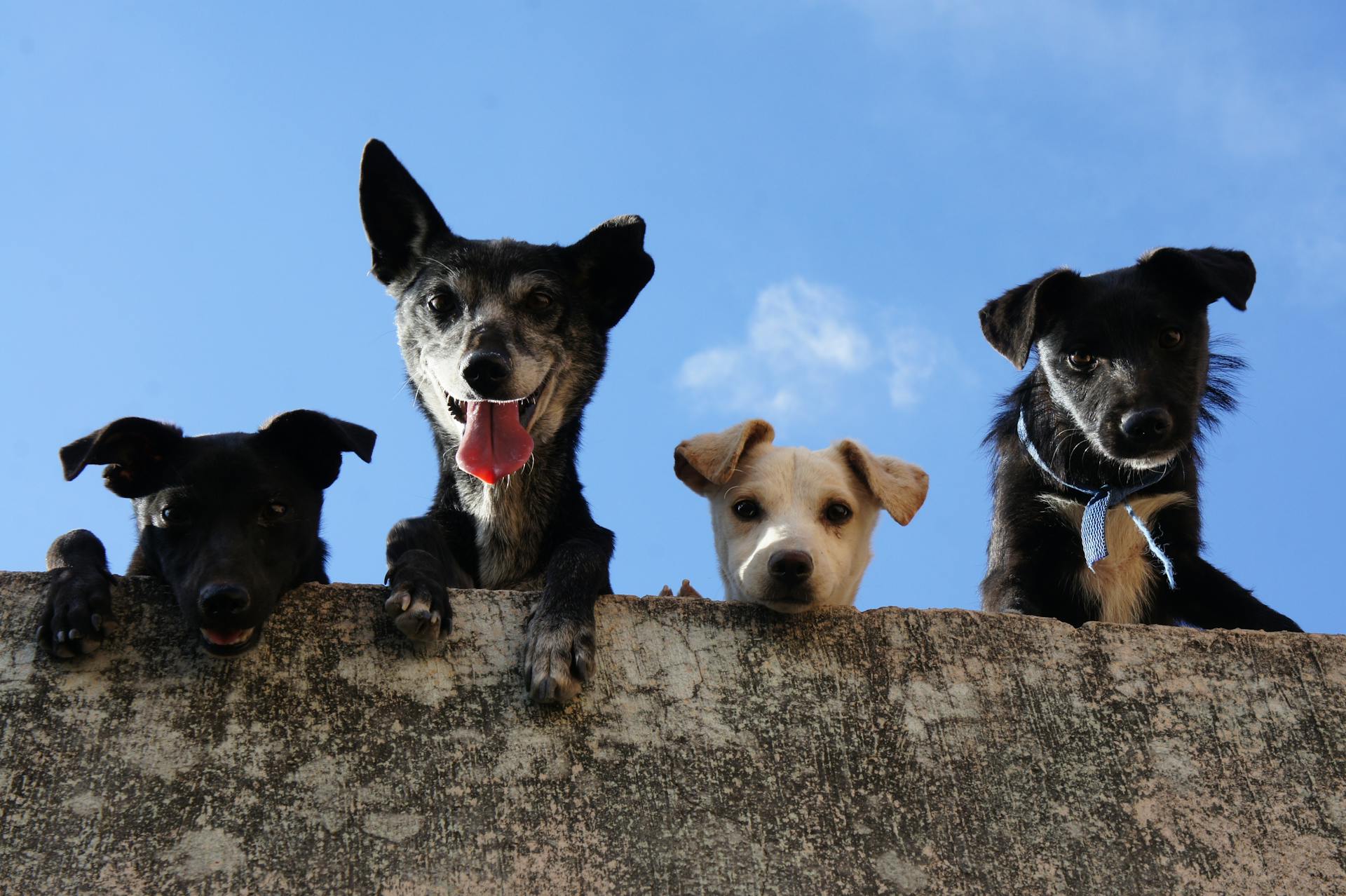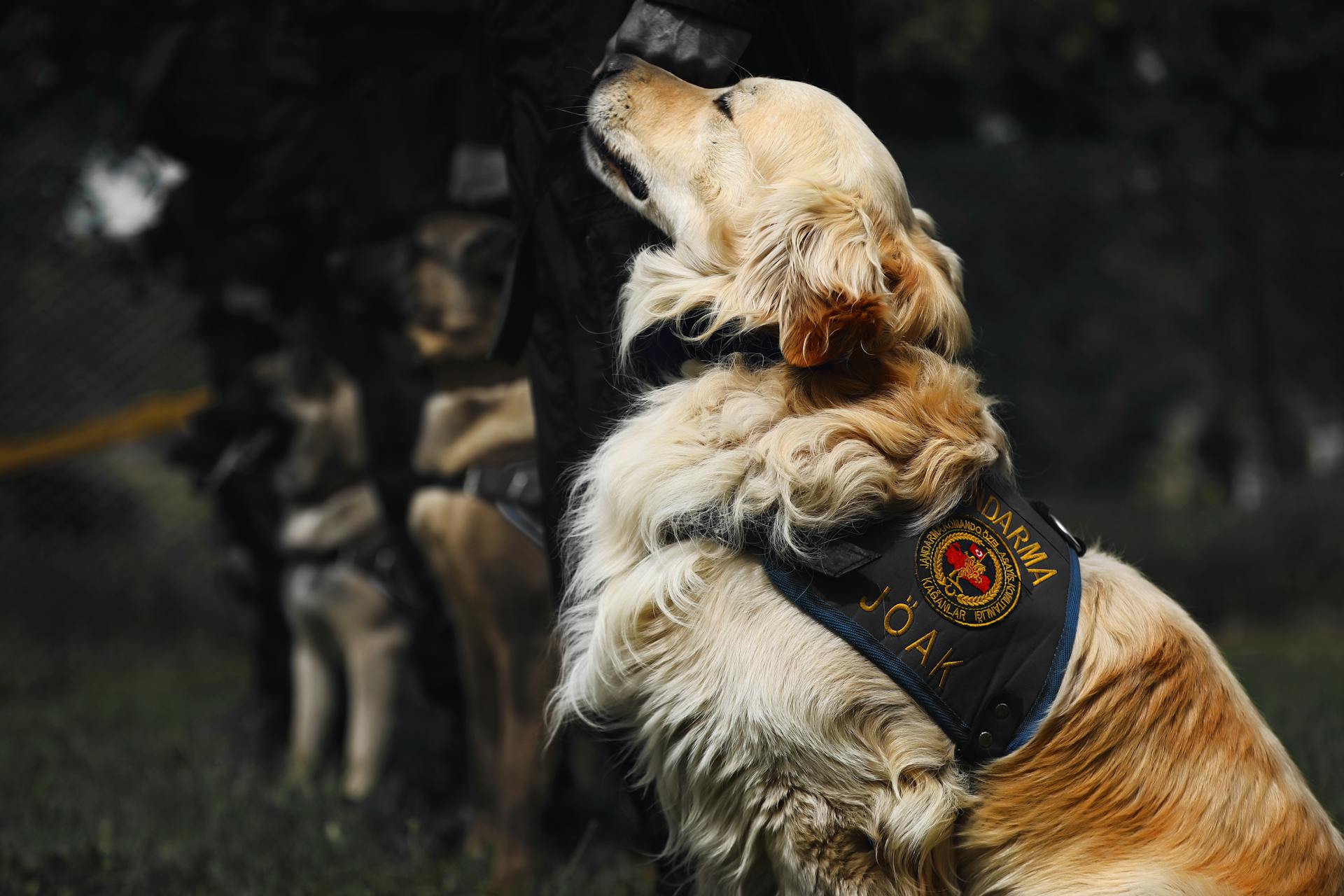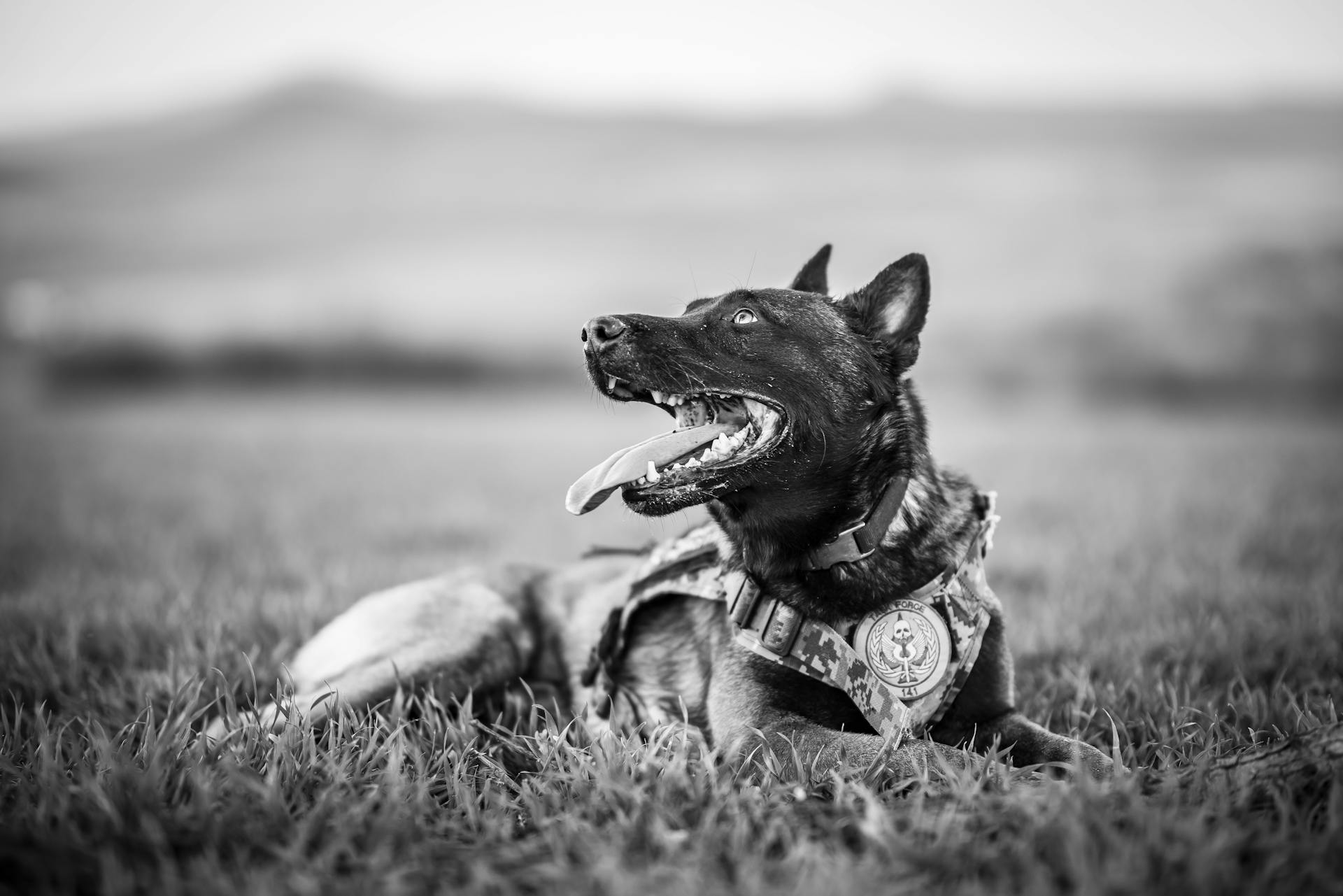
Police service dogs are highly trained canines that play a vital role in law enforcement. They are bred specifically for their intelligence, athleticism, and strong work ethic.
There are several types of police service dogs, including narcotics detection dogs, explosive detection dogs, and patrol dogs. These dogs are trained to detect and track specific scents or substances.
Narcotics detection dogs, for example, are trained to sniff out illegal substances such as cocaine and heroin. They can detect these substances even in small amounts.
Patrol dogs, on the other hand, are trained for general law enforcement duties such as searching for suspects and providing crowd control.
Worth a look: How Do Service Dogs Detect Seizures
Police Service Dog Training
Police service dog training is a lengthy process that begins with the training of the canine handler. The handler must complete police academy training and gain one to two years of patrol experience before becoming eligible for a specialty canine unit.
To become a police service dog, a dog must first pass a basic obedience training course, where they learn to obey commands without hesitation. This allows the officer to have complete control over how much force the dog should use against a suspect.
Check this out: How Do I Become a Search and Rescue Dog Handler
Police service dogs are trained to be either single-purpose or dual-purpose. Single-purpose dogs are used primarily for backup, personal protection, and tracking, while dual-purpose dogs do everything single-purpose dogs do and also detect either explosives or narcotics.
Here are some key differences in training for single-purpose and dual-purpose dogs:
Police service dogs can only be trained for one or the other because they cannot communicate to the officer if they found explosives or narcotics.
Obedience Test
To pass the obedience test, a police dog must be able to obey its handler's commands without hesitation. This is crucial for the dog to be effective in its role.
The dog must be able to complete a basic obedience training course before being considered for a police department. This course teaches the dog to follow commands in a way that allows the officer to have complete control over how much force the dog should use against a suspect.
The commands used in European countries are often given in the country's native language, which makes it easier for the officer to learn new words and commands later on. This is because the dog is initially trained with this language for basic behavior.
Dogs that fail to pass the obedience test are not considered for police work, regardless of their breed or potential. It's a rigorous process, but it's essential for the safety and effectiveness of both the officer and the public.
Check this out: Anxiety in Dogs Body Language
Membership
To become a certified Police Service Dog team, you'll need to join the American Police Canine Association as a regular member in good standing.
This membership requirement is a crucial step in the certification process, as it ensures that teams meet the association's standards.
Police Service Dog teams must be regular members to be tested and certified under the American Police Canine Association's standards.
Suggestion: Do Service Dogs Need Certification
Certification and Standards
The American Police Canine Association (APCA) sets certification standards for police service dog teams, which are designed to determine their proficiency in each phase of police work. Each test is based on a pass/fail basis.
Master Trainers act as the certifying authority for all APCA certification testing, and teams that successfully complete certification testing in a specific phase will be issued a certification certificate, which is valid for one year from the date of issue.
APCA certifications are only valid when the police service dog team is being utilized by their law enforcement agency employer, or by a law enforcement agency in which the team is on official assignment, or by a law enforcement agency requesting mutual aid from the team's employer.
You might enjoy: Dog Training Certificate Online
American Standards
The American Police Canine Association (APCA) sets high standards for police service dogs. The APCA certification standards are designed to evaluate the proficiency of police service dog teams in various aspects of police work.
Each test in the APCA certification standards is based on a pass/fail system. This means that teams must meet specific requirements to pass, and failing to do so will result in a failed certification.
You might like: Certification for Service Dogs in Florida

The APCA certification standards are highly recommended for police service dog teams graduating from accredited training schools. This is because successful passing of these courses is considered acceptable testimony in court.
It's essential to note that the APCA certification standards are based on a pass/fail basis, providing clear and objective criteria for evaluation.
Recommended read: Dog Training Certification Classes near Me
Certifying Authority
The certifying authority for American Police Canine Association (APCA) certification testing is the Master Trainers. They act as the certifying authority for all certification testing.
These Master Trainers are responsible for ensuring that teams successfully complete certification testing in a specific phase. Teams that pass certification testing will be issued a certification certificate that is valid for a period of one year from the date of issue.
Here are the key points about the certifying authority:
- Master Trainers act as the certifying authority for all APCA certification testing.
- They are responsible for ensuring teams successfully complete certification testing.
- Certification certificates are valid for one year from the date of issue.
Training and Specialization
Training a police service dog is a lengthy process that begins with the training of the canine handler. The handler must complete police academy training and gain one to two years of patrol experience before becoming eligible to transfer to a specialty canine unit. This experience allows the handler to gain valuable knowledge in law enforcement.
A dog to be considered for a police department must first pass a basic obedience training course, where it must obey commands without hesitation. This allows the officer to have complete control over how much force the dog should use against a suspect. Dogs are initially trained with commands in their native language, making it easier for the officer to learn new words and commands.
Police dogs can be specialized to perform in specific areas, including apprehension and attack, detection, dual purpose, and search and rescue. Some dogs are trained to detect explosives or narcotics, while others are trained to track and locate suspects or missing people.
Aggression Control Test
The Aggression Control Test is a crucial part of any training program, helping individuals manage their emotions and reactions in high-pressure situations.
This test assesses how well an individual can control their aggressive impulses, which is essential for effective communication and teamwork.
Research suggests that individuals who score high on the Aggression Control Test tend to have better relationships and are less likely to engage in conflict.
In fact, studies have shown that individuals with high aggression control can even diffuse tense situations and calm others down.
Individuals who struggle with aggression control may experience more stress and anxiety in their daily lives.
They may also have difficulty forming and maintaining healthy relationships.
Fortunately, aggression control can be improved through training and practice, making it a valuable skill to develop.
You might like: Impulse Control Dog Training
Area Search Test
The Area Search Test is a critical evaluation of a Police Service Dog's ability to locate a hidden suspect in a large area. This test assesses the dog's proficiency in searching for a suspect without a known track.
The test is conducted in a designated search area, with the Master Trainer observing from a distance to minimize distractions. The Handler begins the test from a starting point outside the search area perimeters, using downwind conditions if present.
See what others are reading: Public Access Test for Service Dogs
The test can be conducted on or off lead, with the lead not being shorter than six feet nor longer than thirty feet. Standard leads, collars, correction collars, or harnesses are allowed.
The test involves three Search Articles of different composition, which are thrown into the search area at random. One of the articles must be of metal composition. The articles may consist of materials like metal, wood, paper, or plastic.
The test is divided into three phases, with the team being tested in a minimum of three different areas. The areas are selected by the Master Trainer, who also determines the search time allocated for the test.
On a similar theme: Do Shock Collars Work for Barking
Specialization
Specialization is a key aspect of police dog training. Police dogs can be specialized to perform in specific areas, such as apprehension and attack, detection, or search and rescue.
Apprehension and attack dogs are trained to locate, apprehend, and sometimes subdue suspects. They are highly skilled and trained in tracking, handler protection, and off-leash obedience.
You might enjoy: What Percentage of Dog Bites Are Pit Bulls

Detection dogs, on the other hand, are trained to detect specific substances such as explosives, drugs, or firearms. Some detection dogs are specifically trained to detect firearms and ammunition.
Search and rescue dogs are used to locate suspects or find missing people or objects. They can be trained to search in various environments, including buildings, vehicles, and open areas.
Here are the different types of police dog specialization:
- Apprehension and attack dogs
- Detection dogs
- Dual purpose dogs
- Search and rescue dogs
These specialized dogs require extensive training and can be used in a variety of scenarios, including open air searching, building searches, and vehicle searches.
Training
Training is a lengthy process that requires patience, dedication, and the right approach. It begins with the training of the canine handler, who must complete police academy training and gain patrol experience before being eligible to transfer to a specialty canine unit.
Prospective canine officers gain valuable experience in law enforcement, which is essential for effective training. Having dog knowledge and training outside of the police academy is also considered an asset.
For a dog to be considered for a police department, it must first pass a basic obedience training course. This course teaches the dog to obey commands without hesitation, allowing the officer to have complete control over the dog's actions.
Dogs are initially trained with commands in their native language, making it easier for the officer to learn new words and commands. This is contrary to the popular belief that police dogs are trained in a different language to prevent suspects from giving commands to the dog.
There are two types of police dog training: single-purpose and dual-purpose. Single-purpose dogs are used for backup, personal protection, and tracking, while dual-purpose dogs detect either explosives or narcotics.
Here are some key differences between single-purpose and dual-purpose dogs:
Police dog training never stops, as trainers and dogs must renew their training regularly to maintain their skills and scent training.
Drug
Drug detection dogs are trained to find narcotics and can distinguish between different kinds of drugs.
Their training is tough and requires them to avoid getting blinded by other smells.
These dogs can even smell narcotics while someone is cooking a steak next to them, making them highly effective detection dogs.
Types of Police Service Dogs
Police service dogs are trained to perform a variety of tasks, and their breeds are chosen for their incredible working ability and desire to cooperate with their handlers.
Some breeds, like the Belgian Malinois and German Shepherd Dogs, are popular choices to be trained as police dogs due to their tenacity in fighting criminals and ability to perform a variety of tasks.
These dual-purpose dogs are trained to perform multiple tasks, including patrolling, searching, and apprehending suspects.
The following breeds are popular choices to be trained as police dogs:
- Belgian Malinois
- German Shepherd Dogs
- Bloodhounds
- Dutch Shepherds
- Labrador Retrievers
Some police dogs are single-purpose, meaning they have one task they perform, while others are trained for multiple tasks due to their breed and training.
Narcotic Detector Test
Narcotic detector dogs are trained to sniff out narcotics in various forms, including powder, pills, and plants.
These dogs can detect even small amounts of narcotics, making them an invaluable asset to law enforcement.
Their highly developed sense of smell allows them to detect the unique scents of different narcotics, including heroin, cocaine, and methamphetamine.
Narcotic detector dogs are trained to detect a wide range of narcotics, but they can also be trained to detect other substances, such as explosives and firearms.
Their accuracy rate is extremely high, with some dogs detecting narcotics 99% of the time.
Their keen sense of smell is also highly resistant to interference from other scents, allowing them to focus on the specific narcotics they've been trained to detect.
Narcotic detector dogs undergo rigorous training to develop their skills, including learning to distinguish between different scents and ignoring distractions.
In a typical narcotics detection test, a dog will be presented with a series of scents, including a control scent and a target scent.
The dog will then indicate the presence of the target scent, which is often a specific type of narcotic.
Their training is so effective that they can detect narcotics even in small amounts, such as a few grains of powder.
Here's an interesting read: Detector Dog
Cadaver
Cadaver dogs are trained to detect human remains and are often used in missing person cases. They have a highly developed sense of smell and can locate a body even if it's been buried for years.
These dogs are trained to search for specific scents associated with decomposition, such as the smell of rotting flesh.
Search and Rescue
Search and Rescue is a critical aspect of Police Service Dogs. In this type of exercise, the dog and handler team must locate a trail that's been laid out by the Master Trainer.
The trail is usually laid out in a simulation of real-world conditions, with the dog and handler starting from a crime scene. The trail is aged a minimum of 4 hours, depending on climatic conditions.
The team must demonstrate proper care of the K9, including providing water, conducting physical examinations, and giving rest periods.
A fresh cross trail is laid by a second person, at least five minutes after the original trail, to test the dog's scent discrimination. The team must then trail for a minimum distance of 1 mile, navigating through various terrain and obstacles.
The handler's control and the dog's ability are evaluated by the Master Trainer, who ensures that the team is not distracted or interfered with during the exercise. The Master Trainer may also use a GPS device to evaluate the accuracy of the Trailing Team.
The team's performance is assessed based on their ability to locate the trail, follow it accurately, and demonstrate good teamwork and communication.
Intriguing read: Cardiac Service Dogs
Popular Dog Breeds
Police dogs are trained from a variety of breeds, each with their own unique characteristics. The Belgian Malinois is one of the most popular breeds, known for their incredible working ability.
Some police dogs are single-purpose, while others are dual-purpose, meaning they're trained to perform a variety of tasks. The German Shepherd Dog is another popular breed, prized for their desire to cooperate with their handlers.
Bloodhounds are also used as police dogs, thanks to their tenacity in tracking and following scents. Dutch Shepherds are another breed that's gaining popularity in police work.
Labrador Retrievers are also used as police dogs, often for tasks that require a gentle touch. Here are some of the most popular police dog breeds:
- Belgian Malinois
- German Shepherd Dog
- Bloodhound
- Dutch Shepherd
- Labrador Retriever
Patrol
Patrol dogs are on the streets as an additional unit. They obtain police dog training in many aspects of day to day police life.
These dogs learn to find suspects, protect their officer, and subdue criminals. They're trained to go above and beyond to help their assigned force.
Suggestion: Crate Training a Dog during the Day
Patrol dogs are often trained to find any drugs that may be present, receiving narcotic scent training as well. This makes them a valuable asset in the fight against crime.
Their training is complex, but it allows them to excel at a single specialization, making them a vital part of the police team.
Frequently Asked Questions
What is the difference between a police dog and a service dog?
Police dogs, also known as K-9's, assist law enforcement, while service dogs help individuals with disabilities. This distinction highlights their unique roles and purposes
What happens to police dogs after service?
Police dogs typically retire with their handler's family, unless in extreme cases. After a career of serving with multiple officers, they usually retire with their last handler.
Which is the best police dog?
There is no single "best" police dog breed, as each breed excels in specific areas, but popular choices include the German Shepherd and Belgian Malinois for their intelligence, agility, and tracking abilities.
Featured Images: pexels.com


